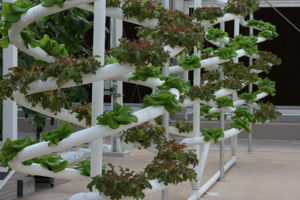Fundamental resources/Food
The decentralization of food production is becoming more and more possible as technology and knowledge grows. Decentralization of food production would allow for a reduction in transport costs and would ensure freshness of the food people eat, which increases its nutritional value and eliminates the need for energy-expensive refrigeration and food storage. However, current methods of decentralized food production are rather labour-intensive. It may be possible to automate these processes (see below), but for now centralized food production requires much less human labour to produce an equivalent amount of food.
If food production is to be decentralized, land use becomes an issue. Estimates of how much land is required to grow a person's food vary, but 60-100 square metres seems reasonable. That means you could grow enough food for 4-7 people on an area the size of a basketball court. In cities, food could be grown under LEDs on stacked shelves, cutting this space to a fraction of that number (e.g. if there were four shelves stacked on top of one another, 15-25 square metres would be needed).
Aquaculture
The New Alchemy Institute did a lot of research into aquaculture - small scale production of fish for eating. They found that a fish tank five feet in diameter and five feet tall can produce forty pounds of fish a year. (Meaning that you could have fish for dinner twice a week.) Ron Zweig developed a method in which the fish tank doubles as a source of hydroponic vegetables - the fish fertilize the plants, the plants clean the water, and both can be eaten by humans.
The New Alchemy Institute developed computer algorithms which could accurately predict the yield of fish based on variables[www.thegreencenter.net/pdf/solaraqua.pdf]
Algae could also be grown on the surface of the water, providing a source of food for the fish so that they would not require feeding. Many species of algae are also edible by humans.
Automation
Because of the high amount of time and labour needed for traditional farming methods, it is worth looking for something easier and more automated.Hydroponics is the growing of plants in a nutrient solution rather than in soil. This allows for precise control of the amount of nutrients that the plants receive. The figures on Wikipedia  , show that hydroponics yields represent an increase on normal growing techniques of about 50% to over 1700%. The precision of control over the growing medium also lends itself to automation more readily than does growing in soil.
, show that hydroponics yields represent an increase on normal growing techniques of about 50% to over 1700%. The precision of control over the growing medium also lends itself to automation more readily than does growing in soil.
LEDs can be used as an alternative to the sun in providing the light for plants to grow. Unlike ordinary lightbulbs, LEDs panels can be designed to emit a full spectrum of light, which is what plants need to grow. LEDs could be useful in situations where sunlight is unavailable - such as in winter in regions far from the Equator, in underground or underwater dwellings, in cities where a demand for space means food must be grown on stacked shelves indoors, and in space stations.
If open collaborative design is applied to researching hydroponic growing of food under LED lights, algorithms could be developed modelling how the nutrient flow, time, duration, intensity and color of light, strains of plants used, and the results of these variables on food yields and flavour, open algorithms could be developed and made available that could accurately predict and optimize how to grow food. Programming these into computers that control the LED lights and the nutrient flow in the hydroponic system would yield a truly automated decentralized food-production system.
